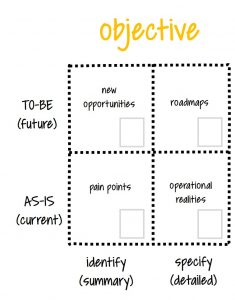Feedback continually highlights the intuitiveness of the DVM concept but when it comes to applying it to build a shared understanding, a pause ensues. To overcome this pause, I have outlined a simple four step guide (based on past examples) to kick start more data conversations.
Step 1 – Set the scene
Okay, the first thing to note is that the DVM is primarily designed as a collaborative tool or discursive template that facilitates shared understanding through productive conversations around data initiatives. As with all good conversations, they are best had with more people than just yourself and to build a shared understanding, the more people you have the better. Long story short, for best results, take one room and add people. No matter where you start, if you don’t engage and converse with others you will never get anywhere near the potential value that the DVM has to offer. Also, it goes without saying, getting the right people in the room will provide a much more productive conversation. Try and include people from different areas with different roles to facilitate a rich discussion with multiple perspectives. Once you have your room and people, sprinkle with sticky notes and as large a printout of the DVM as possible. Having an A0 works very well as it allows people to engage in conversations and discussions by placing and moving the sticky notes on the DVM.
Step 2 – Define the objective
The next step is to decide what your collaborative conversation will focus on. Taking a literal leaf out of Dan Roam’s book, the concept of SQVID is taken and simplified within the context of data conversations and provides four potential starting points. These come from the time-frames you can base conversations around: (the to-be or as-is state) and the depth of conversation you want to have (high level summary or detailed). For the most part summary implementations are presented on a single DVM, tend to synthesise differing perspectives and highlight common trends and priorities. They also can act as a nice stepping stone into identifying more specific areas for further (detailed) DVM investigations. On the other hand, detailed implementations aim to lift the lid on a predefined focus. Challenging all assumptions (not taking anything for granted), discussions can generate multiple DVM’s to detail the depth of the conversations. Putting these two together, you end up with a 2×2 matrix and four main starting points (i) new opportunities, (ii) pain points, (iii) operational realities, and (iv) roadmaps.

Figure 1: Typical DVM starting objectives
Step 3 – Facilitate conversation and understanding
The next step is about facilitating and reflecting on constructive discussion. Provide the opportunity for everybody to contribute, generate consensus, challenge group-think, build a shared vision and understanding. This step is easy for some and difficult for others. For those who find it difficult, leverage the DVM as pointers for discussion. For instance, use the sticky notes and group common trends (words, problems or opportunities) into one of the sections on the DVM, use the six questions (what, why, when….) to highlight similarities and differences, or classify benefits by category (stop, start, improve). Do not try and impose your own understanding on the group but instead let the understanding evolve.
Step 4 – Record and distribute for feedback and reiterate
Once the conversations are finished, record the output. This may be in the form of a photo or a digital version (e.g. a slide deck), which can be distributed to the participants to encourage further feedback. The output will only record a snapshot of the level of understanding created and while it may not record all the richness of discussion, it can be a springboard for future conversations and actions.
Final parting bits of advice. It is always worth remembering that the value is not in the tool itself but in the conversations it creates. So make sure you listen as much as you talk and try and make sense of other perspectives. Most importantly, the guide is only a guide, so don’t make it a straight jacket. There are multiple ways to use the DVM and once you get familiar with it, you will find out what works for you.
